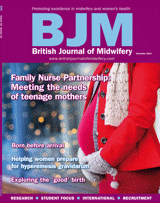References
Helping women prepare for hyperemesis gravidarum
Abstract
Hyperemesis gravidarum is a serious complication of pregnancy presenting as prolonged and severe nausea and vomiting causing dehydration, malnutrition and significant morbidity. Women with a history of hyperemesis gravidarum have around an 80% chance of suffering in subsequent pregnancies. Careful and thorough planning in advance of future pregnancy can significantly reduce the overall severity of symptoms and improve the psychosocial welfare of the women as well as pregnancy outcomes. This article explores the various aspects of a thorough prophylactic care plan to optimise the outcomes of future pregnancies and reduce the morbidity associated with hyperemesis gravidarum. The evidence-base for the following aspects are discussed to ensure a holistic care plan can be developed: physical preparation, prophylactic medication, criteria to assess deterioration, further treatment options if required, and psychosocial management
Nausea and vomiting affects around 80% of pregnant women to a greater or lesser degree making it the most common medical condition in pregnancy (Gadsby and Barnie-Adshead, 2011). Around 30% of women will be severely affected; however, only 1–1.5% of pregnant women will be admitted to hospital with extreme nausea and vomiting, known as hyperemesis gravidarum (Gadsby and Barnie-Adshead, 2011). With 729 674 live births in the UK in 2012, admissions for hyperemesis gravidarum (HG) are significant at nearly 11 000 across the UK (Office for National Statistics (ONS), 2013). Furthermore, the rate for therapeutic termination for HG is estimated to be 10% in the UK, accounting for further morbidity and admissions (Poursharif et al, 2007; Pregnancy Sickness Support, 2013). In the financial year of 2003/04, the cost for admission for HG in England was estimated to be at £36 481 745 (Gadsby and Barnie-Adshead, 2011). It is the most common reason for hospitalisation in early pregnancy and the second most common reason throughout pregnancy—preterm labour being the first (Goodwin, 2008).
Register now to continue reading
Thank you for visiting British Journal of Midwifery and reading some of our peer-reviewed resources for midwives. To read more, please register today. You’ll enjoy the following great benefits:
What's included
-
Limited access to our clinical or professional articles
-
New content and clinical newsletter updates each month

